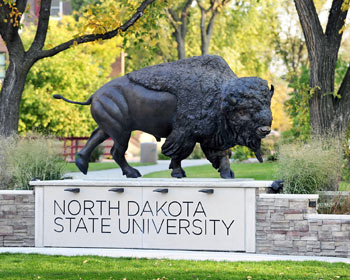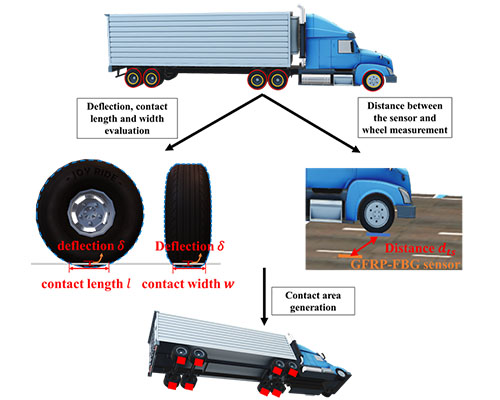|
|
MPC Region Info
North Dakota State University North Dakota State University (NDSU) is a student-focused, land-grant, research university. NDSU, via its Upper Great Plains Transportation Institute (UGPTI), is the lead university in the MPC and the UGPTI is the focal point for most MPC activity on campus. The UGPTI is an interdisciplinary center, providing innovative transportation research, education and outreach that promote the safe and efficient movement of people and goods. The UGPTI was created in 1967 at NDSU by the North Dakota Legislature. It now has an annual budget of about $10 million. Approximately 50 staff are located at two locations: NDSU in Fargo and Bismarck. The UGPTI also employs about 50 graduate and undergraduate students. Areas of staff expertise include, infrastructure modeling and needs analysis, rural and small urban transit, traffic analysis, Intelligent Transportation Systems, agricultural and freight logistics, low-power sensing, wireless communications, mobile computing, rural transportation and safety, and software and database systems in support of commercial vehicle inspection and enforcement. UGPTI is also home to the ND Local Technical Assistance Program, an outreach program facilitating the exchange of transportation technology among local units of government. That exchange of technical knowledge is also reflected in UGPTI's emphasis on tribal outreach. North Dakota State University (NDSU) is a student-focused, land-grant, research university. NDSU, via its Upper Great Plains Transportation Institute (UGPTI), is the lead university in the MPC and the UGPTI is the focal point for most MPC activity on campus. The UGPTI is an interdisciplinary center, providing innovative transportation research, education and outreach that promote the safe and efficient movement of people and goods. The UGPTI was created in 1967 at NDSU by the North Dakota Legislature. It now has an annual budget of about $10 million. Approximately 50 staff are located at two locations: NDSU in Fargo and Bismarck. The UGPTI also employs about 50 graduate and undergraduate students. Areas of staff expertise include, infrastructure modeling and needs analysis, rural and small urban transit, traffic analysis, Intelligent Transportation Systems, agricultural and freight logistics, low-power sensing, wireless communications, mobile computing, rural transportation and safety, and software and database systems in support of commercial vehicle inspection and enforcement. UGPTI is also home to the ND Local Technical Assistance Program, an outreach program facilitating the exchange of transportation technology among local units of government. That exchange of technical knowledge is also reflected in UGPTI's emphasis on tribal outreach.
The UGPTI in conjunction with the College of Business offers multidisciplinary programs of course work and experiential learning that prepares professionals for careers in transportation and logistics. Options include: doctorate in transportation & logistics, master of supply chain management, master of transportation and urban systems, and multiple graduate certificate options in transportation and logistics.  News ArticleJones is 2024 CTIPS Student of the Year (Dec 2024) Full Article University Labs / Resources- Traffic modeling is a key strength for UGPTI. Staff developed detailed rural road traffic models to estimate traffic volumes on North Dakota's road network. Staff use the models to estimate the impact to state, county and local roads due to oil development in the Bakken formation in North Dakota and Montana. In addition, changing agricultural production and marketing practices and their impacts on North Dakota's road network are analyzed.
- Advanced Traffic Analysis Center (ATAC) collects and analyzes traffic data to support decision makers who plan, operate, and fund transportation systems at the local, regional, and state level. Primary areas of work include intelligent transportation systems, traffic operations, and metropolitan transportation planning and travel demand modeling.
- Center for Surface Mobility Applications and Real-time Simulation environments (SMARTSe) collects and analyzes traffic data to support decision makers who plan, operate, and fund transportation systems at the local, regional, and state level. Primary areas of work include intelligent transportation systems, traffic operations, and metropolitan transportation planning and travel demand modeling.
- Commercial Vehicle Safety Center (CVSC) is a point of contact for universities, law enforcement, and driver licensing agencies looking to establish partnerships to improve commercial vehicle safety. CVSC sponsors webinars and provides resources in addition to conducting research and analysis. Research focuses on analyses intended to identify unsafe commercial vehicles, drivers, and companies, as well as streamlined methods to provide this information to state and federal safety enforcement specialists.
- DOT Support Center (DOTSC) provides engineering design assistance and transportation information technology support to transportation managers to ensure the safe and efficient movement of people and goods. Undergraduate engineering students in the center work under the direction of DOT engineers to prepare plans, estimates, and studies for real world projects. Computer science students provide IT support and assist staff in the development of applications such as a local road surface selection tool, the online ND Truck Weight Calculator, and the Geographic Roadway Inventory Tool (GRIT).
- North Dakota Local Technical Assistance Program (NDLTAP) fosters safe, efficient, environmentally sound and cost effective highway, road, and street systems by exchanging technology with local units of government and the transportation community through training, technical assistance, and information services. Key areas for hands-on, online, and distance training include safety, gravel road management, construction topics, rural road maintenance, and asset management.
- Rural Transportation Safety and Security Center (RTSSC) promotes and enhances the region's transportation safety and security through research, education, and outreach. Staff members conduct safety analyses to evaluate and guide local, state, and federal initiatives. RTSSC's research tracks trends in road safety factors, such as impaired drivers, youthful drivers, and occupant protection.
- Small Urban and Rural Center on Mobility (SURCOM) increases the mobility of small urban and rural residents in the United States and abroad through innovative research, education, training, and outreach. Key areas for training include leadership and management. Recent research has focused on mobility for those aging in place, estimating demand for intercity bus services, bike share impacts on transit, and mobility needs in rural communities.
- Transportation Learning Network (TLN) supports safe and efficient transportation through a network of people and technology that serves members by enhancing communication, workforce development, education, professional development, technology transfer, and research. TLN initiatives focus on assuring that DOT employees and others in the transportation workforce are prepared to implement new technology, work safer, and complete technical tasks accurately and efficiently. TLN is a collaborative effort of MPC universities and participating DOTs.
Department InformationUpper Great Plains Transportation Institute
North Dakota State University
NDSU Dept 2880
PO Box 6050
Fargo, ND 58108-6050
Phone: (701)231-7767
Email: ndsu.ugpti@ndsu.edu |

